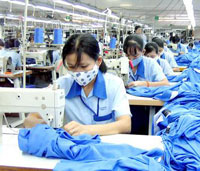"A major source of environmental contamination, the global fashion industry, emits 10 per cent of the greenhouse emissions annually. Due to its long supply chain and energy-intensive production, the industry consumes more energy than aviation and shipping combined. As most of the clothing manufacturing is now undertaken in India and China, coal-fired power plants and GGEs predominate while employee rights are ignored."
 A major source of environmental contamination, the global fashion industry, emits 10 per cent of the greenhouse emissions annually. Due to its long supply chain and energy-intensive production, the industry consumes more energy than aviation and shipping combined. As most of the clothing manufacturing is now undertaken in India and China, coal-fired power plants and GGEs predominate while employee rights are ignored. Though the western companies outsourced jobs by moving their production to these companies, they also increased the impact of pollution and environment in these countries, threatening the health of local people.
A major source of environmental contamination, the global fashion industry, emits 10 per cent of the greenhouse emissions annually. Due to its long supply chain and energy-intensive production, the industry consumes more energy than aviation and shipping combined. As most of the clothing manufacturing is now undertaken in India and China, coal-fired power plants and GGEs predominate while employee rights are ignored. Though the western companies outsourced jobs by moving their production to these companies, they also increased the impact of pollution and environment in these countries, threatening the health of local people.
As per Natural Resources Defense Council (NRDC), textile factories in China, which makes over 50 per cent of the world’s clothing also releases three billion ton of soot every year by burning coal, contaminating the air leading to respiratory and heart disease. Textile mills generate 20 per cent of the world’s industrial water pollution and use 20,000 chemicals, many of them carcinogenic. Textiles are the largest source of synthetic fibers in the oceans, micro-plastics get into the water system every time garments are washed; the UK House of Commons Environmental Audit Committee on fashion reports that “a single 6kg domestic wash has the potential to release as many as 700,000 fibers.”
the world’s clothing also releases three billion ton of soot every year by burning coal, contaminating the air leading to respiratory and heart disease. Textile mills generate 20 per cent of the world’s industrial water pollution and use 20,000 chemicals, many of them carcinogenic. Textiles are the largest source of synthetic fibers in the oceans, micro-plastics get into the water system every time garments are washed; the UK House of Commons Environmental Audit Committee on fashion reports that “a single 6kg domestic wash has the potential to release as many as 700,000 fibers.”
Fast fashion causes immense damage
Different fabrics impact the environment at different levels. Synthetic fibers like polyester, made from crude oil (fossil fuel), produce higher levels of GGEs compared to natural materials. However, it can be recycled, is more stain-resistant, can be washed in cold water and dries quickly. Conventional cotton causes deforestation and loss of biodiversity, and is responsible for 18 per cent of all pesticides and 25 per cent of insecticides. Cotton also consumes around 2,700 liters (715 gallons) of water to make a single t-shirt.
The material also uses huge amounts of water for its dyeing process. According to the World Resources Institute, globally 5 trillion liters (1.3 trillion gallons) of water are used each year for fabric dyeing. The most polluting area of the apparel industry, fast fashion, produces 50 ‘cycles’of clothing every year. Increasing consumerism, this fad has led to huge amounts of waste and cause immense environmental damage. It needs to be stopped urgently.
Creating a holistic experience
The fashion industry, since long has been advocating strong measures to stop its damaging effects on the environment. Last year a group of organisations, under the umbrella of the United Nations Climate Change, created the Fashion Industry Charter for Climate Action (FICCA), launched at COP24 in Katowice, Poland, in December. The FICCA aims to reduce greenhouse gas emissions by 30 percent by 2020 and achieve zero emissions by 2050. Its 43 founding companies include brands like Adidas, Burberry, Esprit, Guess, Gap, H&M, Kering, Levis, Puma, PVH and Target.
To reduce the catastrophic impact of fashion, brands plan to review their production methods and water use, curtailing demand, moving from conventional to organic cotton and from virgin polyester to recycled polyethylene terephthalate (PET), collecting and recycling unwanted garments. In addition to these brands, governments should also introduce public information policies to make people aware of the environmental impact of living a certain way and introduce maintenance classes in schools. All product-based companies should make their consumers aware about the environmental impact of their products and methods, as well as the human cost. They also need to regulate their advertising campaigns.
To address this environmental catastrophe, brands need to create social justice and a holistic life experience in their countries. They also need to eliminate competition and conformity from their society, reject its focus on brand image and also curtail the tendency to imitate. The challenge of environmental pollution can be overcome by moving away from a life based on desires and cultivating the natural world and the art of living harmlessly. Brands also need to pressurise the government to halt this catastrophe before it gains mammoth proportions.












